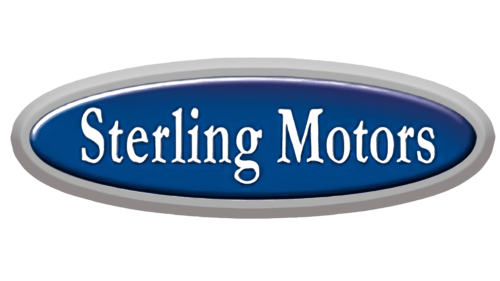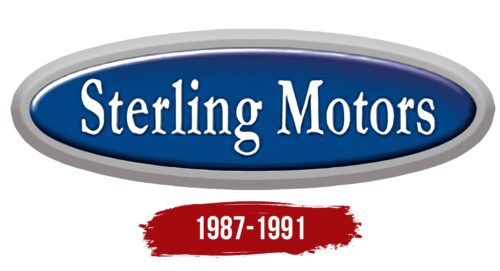The Sterling logo conveys the former glory of luxurious British cars that briefly shone in the American market. The emblem reflects the noble minimalism and enhanced comfort that distinguished these vehicles.
Sterling: Brand overview
The Sterling automobile brand was founded in 1987 in the United Kingdom. It resulted from a partnership between the Japanese automaker Honda and the British firm Austin Rover Group, which became known as Rover Group. The American market was the primary target for creating the luxury brand.
An early 1980s deal between Austin Rover and Honda was the basis for creating the new brand. The firms worked together to design new car models using this arrangement. The Rover 800, the foundation for the automobiles, was one of the outcomes of this partnership.
The 825 sedan debuted in 1987 and was the first and only model under the brand. This vehicle was a redesigned Rover 825 with a few tweaks for the US market. With its 2.5-liter Honda V6 engine, the 825 was a powerful and plush premium vehicle.
A significant marketing campaign was launched with the introduction to the US market. The firm marketed its vehicles as a British take on high-end German and Japanese products. They provided high comfort, luxurious amenities, and a distinctly British aesthetic.
At first, sales figures appeared encouraging. About 14,000 cars were sold in 1987, a positive sign for a new brand entering the US market. But issues quickly started to surface.
The primary problem was the construction quality. The automobiles had several flaws, even with the trustworthy Japanese parts, especially the electronics and interior finish. As a result, American consumers’ perception of the brand swiftly declined.
The 827 model, an upgraded version, was unveiled in 1989. It had a 2.7-liter engine with greater power and several upgrades to the equipment and design. However, these adjustments were unable to stop the declining sales trend.
By 1991, it was evident that the brand had not succeeded in making a name for itself in the US market. Sales fell every year, and the brand’s standing was severely harmed. Consequently, the choice was made to stop selling these vehicles in the United States.
When it was in operation, roughly 35,000 vehicles were sold between 1987 and 1991. This fell far short of the original projections and prevented the brand’s development and promotion costs from being recovered.
The end of US sales was a serious setback for Rover Group. The business lost a lot of money and the chance to join the premium market in the United States. This incident also hindered intentions to expand further worldwide.
Despite its brief existence and lack of success in the marketplace, the brand is still a fascinating chapter in British auto history. This experience highlighted European producers’ difficulties when trying to break into the very competitive American market and the significance of maintaining excellent product quality for success in the premium market.
Meaning and History
What is Sterling?
In 1987, Sterling Motor Cars, the North American arm of the esteemed Rover Group, made a resounding debut in the United States. This daring venture was facilitated by a tactical alliance with Honda of Japan, propelling the brand into a prominent spot in the American automotive landscape. Despite its relatively brief stint, Sterling vehicles left a lasting mark with their superior quality and performance, resonating with drivers until 1991. Sterling, an extraordinary brand birthed from the joint efforts of Austin Rover and Honda, was conceived by the legendary British car manufacturer Austin Rover. Headquartered in the United Kingdom, Sterling’s base proudly showcased its British roots and design influences. With its distinctive and inventive design, Sterling symbolized the shared spirit of ingenuity and collaboration between Austin Rover and Honda.
1987 – 1991
The fundamental element of the Sterling logo is a refined oval. It is considered refined not for its robustness but for its elegance. It embodies the spirit of English aristocracy, noble manners, and a quest for comprehensive comfort. However, competition prevented the company from developing further, and its logo has frozen in time, showcasing the sophistication of luxurious cars now considered collectibles.
The name of the forgotten British brand is in the center of the narrow, horizontally placed ellipse. It is written in a classic font with tiny serifs, barely noticeable on the large, bold white letters. This inscription is non-aggressive, pleasant, and clearly visible against the blue background. The initial glyphs of each word are in uppercase, while the rest are in lowercase. The moderate combination of thin serifs and soft curves creates a soothing aura, instilling confidence in the brand’s cars.
The top of the oval is outlined in white, and the bottom in black. This unique contrast adds variety to the logo, brings it to life, and gives it dimension. Such restrained dynamism is characteristic of British nature, fitting harmoniously into the emblem’s design and conveying its authenticity and purely English charm.
There is also a large amount of gray color with a gradient ranging from ash to silver. This is mainly used for the frame, which appears convex due to the play of shadows and light as if it has a raised edge in the middle. This detail also transforms the drawn symbol into a realistic emblem, ready to adorn the hoods of the brand’s cars.





